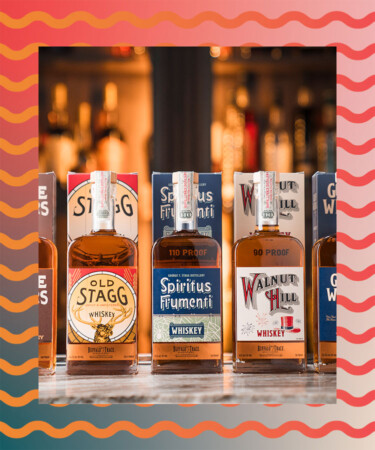Read or watch our full review of the Buffalo Trace Prohibition Collection here!
On Monday, Buffalo Trace announced the launch of the Prohibition Collection: a five-bottle collection of whiskeys that honors the spirits legally produced at the distillery during Prohibition. The collection, set to launch in October, is a recreation of five Prohibition-era whiskeys that have, until now, been lost to time: Old Stagg, Golden Wedding, Three Features, Walnut Hill, and George T. Stagg Spiritus Frumenti.
Known then as the George T. Stagg Distillery, Buffalo Trace is the longest continually-operating distillery in the United States and one of just six establishments to be granted a license to produce medicinal whiskey by the U.S. government from 1920 to 1933. Each of the whiskeys in the Prohibition Collection serves as a tribute to the brands housed at the distillery during this 13-year period.
“When we discovered these brands — and others — in our distillery’s history, we could not wait to bring them back to life and tell their stories again,” says Andrew Duncan, global brand director for Buffalo Trace. “By aging and selling barrels from numerous distilleries all over the country, the Buffalo Trace Distillery site played a key role in keeping American [w]hiskey alive during one of the most unique periods in the history of the spirits industry.”
Each whiskey in the Prohibition Collection is housed in 375-milliliter bottles inspired by each spirit’s respective original packaging, including the labels’ spaces where doctors would have written their prescriptions for medicinal whiskey. Housed in a custom wooden case containing all five bottles, the Prohibition Collection is set to roll out in limited quantities to select retailers, bars, and restaurants across the U.S. at a suggested retail price of $999.99.
“We stand behind our motto, ‘Honor Tradition, Embrace Change’,” says Harley Wheatley, master distiller for Buffalo Trace. “Each of these brands disappeared slowly in the years after Prohibition, but they were integral to our survival. Without them, today there would be no Buffalo Trace, Eagle Rare, or Weller bourbons. The Prohibition Collection is a tribute to these great whiskeys from our past.”
Read on for more details about each bottle in the collection.
Old Stagg
Originally distilled in honor of the distillery’s former owner, George T. Stagg, Old Stagg actually replaced O.F.C. Bourbon as the distillery’s flagship label. Bottled at barrel proof, uncut, and unfiltered, Old Stagg inspired other barrel-proof bourbon labels like Stagg and George T. Stagg. According to the brand, Old Stagg delivers aromas of oaky vanilla with a sweet, mellow palate of smooth vanilla and leather.
Golden Wedding
Bottled at 107 proof, Golden Wedding is a rye whiskey that dates back to 1869. Produced by Schenley Distilling at the Joseph S. Finch Distillery in Pennsylvania, Golden Wedding was physically bottled by both Schenley’s and the George T. Stagg Distillery in Frankfort, Ky. during Prohibition. By the 1940s, production of Golden Wedding had been moved to Canada, and by the 20th century, it would cease to exist — until now. The brand says spirit carries heavy rye spice on the nose with a grainy, herbal palate boasting dill pickle notes and a smokey finish with a hint of banana.
Three Feathers
Three Feathers’ roots stretch as far back as 1812 when it was initially advertised as a luxurious sipping rye, before it was transformed into a bonded whiskey and later a blended whiskey. Envisioned by Buffalo Trace master distiller Drew Mayville, the Prohibition Collection’s recreation of the historic whiskey is bottled-in-bond at 100 proof with vanilla and charred oak aromas, a tropical and stone fruit palate, and caramel and cocoa finish.
Walnut Hill
Distilled to 90 proof, Walnut Hill is a high-rye bourbon that the brand says conveys citrus aromas and a smokey, woodsy palate with sweet molasses. The spirit celebrates the bourbon of the same name that was produced at the distillery during Prohibition with oversight handled by Albert Blanton himself, the distillery’s then-president.
George T. Stagg Distillery Spiritus Frumenti
Coming in at 110 proof, George T. Stagg Distillery Spiritus Frumenti is the booziest of the Prohibition Collection’s offerings. Literally translating from Latin to “spirit of the grain,” Spiritus Frumenti was the generic name used to label medicinal whiskey during Prohibition. The brand says the wheated bourbon provides caramelized brown sugar aromas with a fruity, floral palate of cherry and oak with a vanilla and citrus finish.
